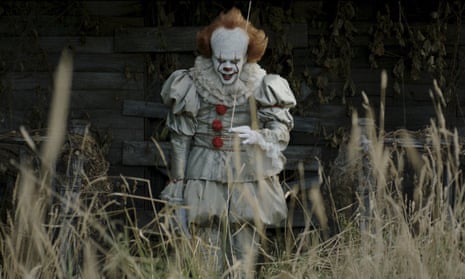Not so long ago, the big-screen take on Stephen King’s It seemed to be heading down the storm drain into a whirling purgatory of corporate clumsiness. The film’s original director, True Detective’s Cary Fukunaga, quit in 2015, following a reported dispute over budget restraints with studio New Line. Then Will Poulter, Fukunaga’s first choice for Pennywise the Clown, the most famous incarnation of the shape-shifting, fear-imbibing monster of the title, was forced off the project due to scheduling conflicts.
Yet somehow, here we are two years later with a movie directed by the Argentine horror film-maker Andrés Muschietti that has a 90% “fresh” rating on the review aggregator Rotten Tomatoes and has been praised by both King and Tim Curry, who played Pennywise so memorably in the flawed but occasionally glorious 1990 TV miniseries. So how does the new It compare to the TV version, and is Bill Skarsgård’s leering killer clown a patch on Curry’s? Here is your chance to weigh in on the film’s key talking points.
Remake versus original
Released in 1990 in two parts by ABC in the US, the first It is a troubling beast. Frankly, if there was ever a good case for a remake, this was, well, it. While Curry’s performance is among his most memorable, the films suffer from the lower production values inherent in television movie-making at the time. The acting is pretty shonky in places, and the giant spider that It transforms into for the climactic battle is one of the most infamous examples of terrible special effects work ever seen on any screen, big or small.
By contrast, the new It feels loved by its makers. Muschietti gives a glimpse into the dark heart of each member of the Losers Club, the gang of outsiders who decide to rid the small town of Derry, Maine, of the hideous Pennywise. Most of us, while growing up, came into contact with a Henry Bowers, the sociopathic local bully who terrorises the geeks and freaks of Derry in King’s book. And while the movie personifies the torment and horror of teenage existence as a burlesque clown, we can all recognise the feeling of always having to keep an eye out for danger. This It’s chills feel genuine and earned.

The unsettling Stranger Things synergy
Without Stranger Things, Netflix’s paean to King and spooky 1980s cinema, it is unlikely the new It would have achieved as much buzz. If the producers did not actively seek to cash in on the Duffer brothers’ vivid tale of small-town supernatural goings-on, they have certainly done little to dispel the sense that Muschietti’s film can be viewed as a companion piece to the TV series. The casting of Finn Wolfhard, the 14-year-old Canadian actor who played Mike Wheeler in Stranger Things, as Richie Tozier may have been a coincidence, but it’s not the only similarity between the two.
It and Stranger Things are both set in a small rural town beset by a supernatural entity, both feature groups of children who feel cut off and disconnected from their peers, and both feature a female newcomer who shakes things up in unexpected ways. New Line has even moved the timeline of King’s novel from the 1950s to the 1980s, bringing It into line with the period setting of its TV cousin. All this was probably to be expected, given that Matt and Ross Duffer only created Stranger Things after their pitch to direct It was turned down by Warner Bros.
Would you agree that none of this is really an issue? For while It lacks Stranger Things’ depth and doesn’t have the TV show’s startlingly good adult cast, it makes up for any shortfalls with sheer bloodthirsty insouciance. Where Stranger Things is closer to supernatural sci-fi, It’s horror leanings are plain for all to see.
Bill Skarsgård as Pennywise
Yes, Skarsgård has the aid of prosthetics to add to the killer clown’s sideshow freakishness, whereas Curry relied on his natural proficiency for physical theatricality. But the Swedish actor’s take on It, from the moment we first see him in that murky storm drain, is a revelation. There may be something of Heath Ledger’s Joker, and a Depression-era New Yoik gangsterism to Skarsgard’s vowels, but his ability to go from quiet, leering menace to nightmarish attack mode in a split second is a big part of the appeal. The Swede also seems to have coaxed better performances from his youthful co-stars than Curry managed. Certainly there is a twisted, curdled connection between the clown and his victims that feels horribly real.
The trouble with (and genius of) children’s horror
One of the reasons Stephen King is an iconic writer is that he ventures into territory others fear. Children’s horror is a tricky sub-genre because the idea of deriving entertainment from viewing the abuse of those members of our society who are too young to protect themselves seems wrongheaded in the extreme. Yet it is for precisely this reason that It retains the power to shock. If you weren’t outraged, at least momentarily, when tiny, defenceless Georgie had his arm ripped off by Pennywise in the opening moments of Muschietti’s film, then the director really wasn’t doing his job.
Part two
A cheap trick, to turn what was always intended as a two-part project into a standalone movie and its sequel, you might think, via that final-scene reveal. But who wouldn’t be back for part two after witnessing the excellence of the first film – if only to see if they make a better job of the interdimensional giant spider this time around.

Comments (…)
Sign in or create your Guardian account to join the discussion